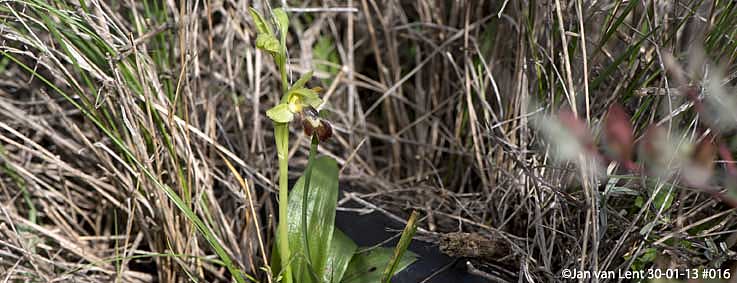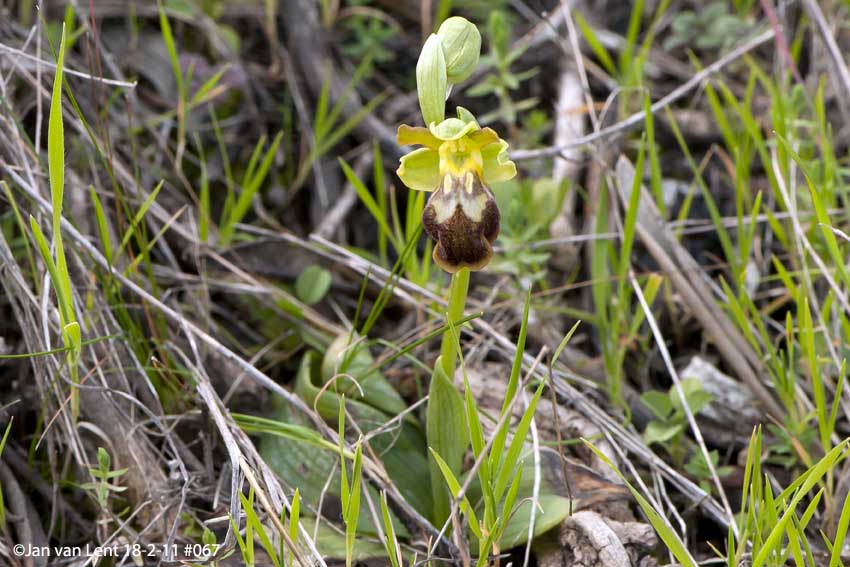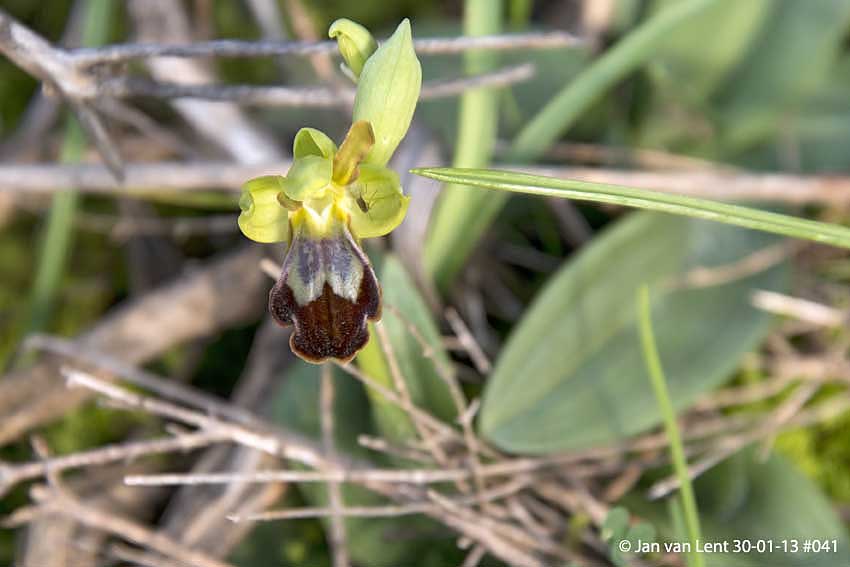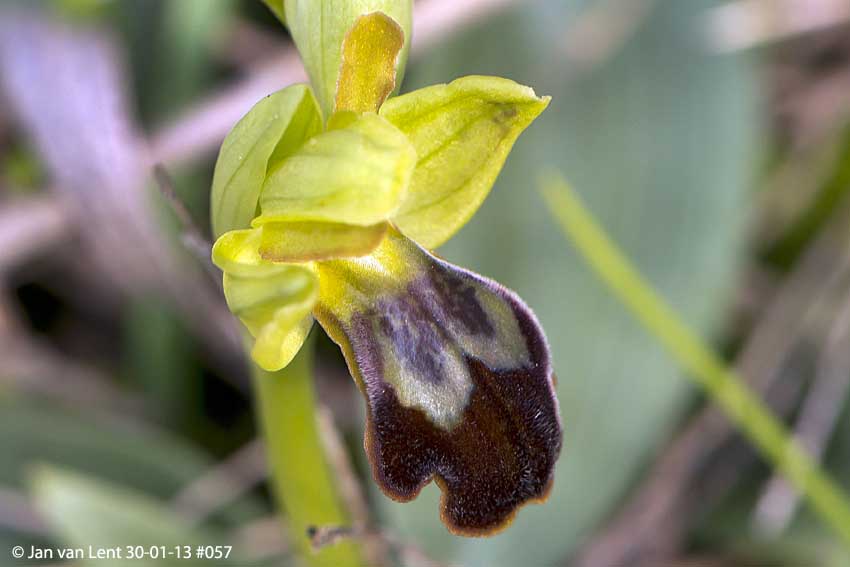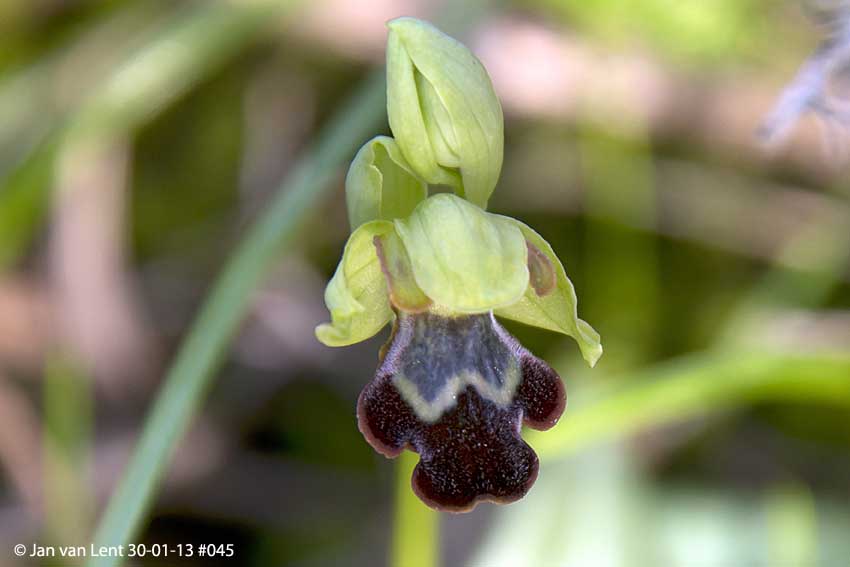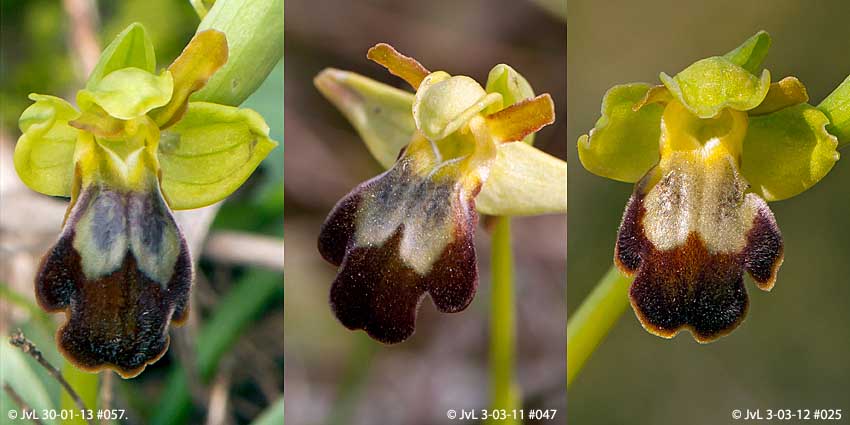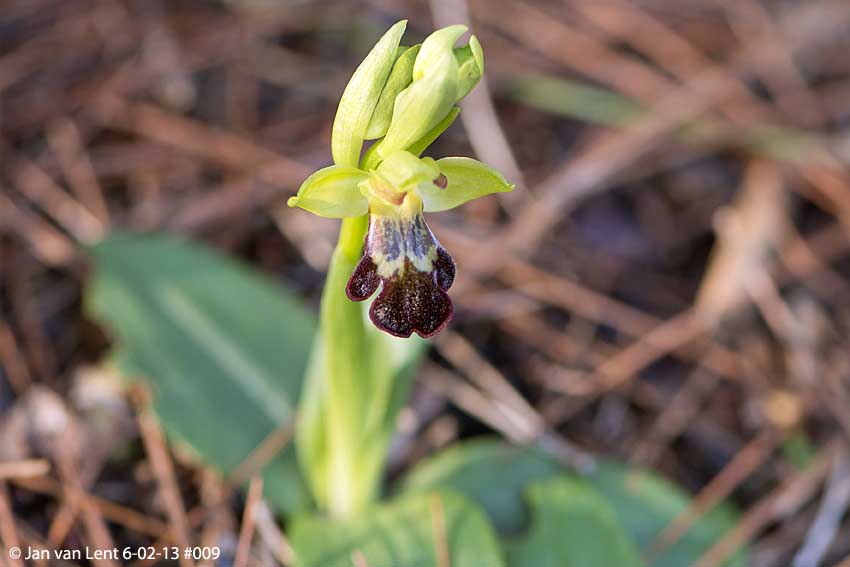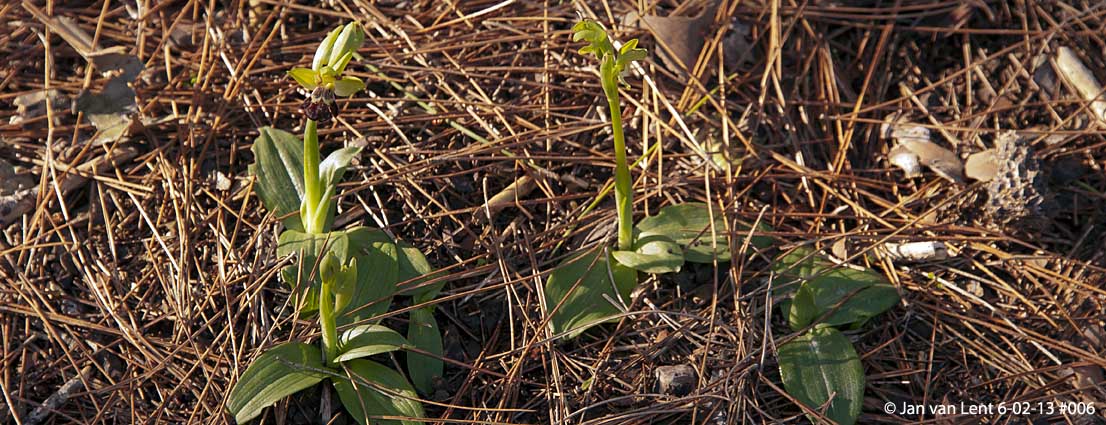Habitats: Alifantá, Anemomílos, Lambou Míli, Plakés, Mixou.
Ophrys sancti-isidorii or Ophrys leucadica? Alifantá, © JvL 30-01-13 #016
Ophrys (fusca ssp.) sancti-isidorii A. & P. Saliaris & Albertis 2010, or
Ophrys (fusca ssp.) leucadica Renz 1928.
The Fusca group, on Lesvos also: Ophrys calocaerina, Ophrys cinereophila.
HUNTING: On one of the last days of last month, the 30th of January, I decided to have a look at my Ophrys habitats in the south-east of Lesvos to see if there were already any Ophrys around this early in the season. I went there because SALIARIS & ALIBERTIS (Chios 2010) and TAYLOR (Chios 2012) described a very early Ophrys from Chios flowering between January and early April: Ophrys (fusca ssp.) sancti-isidorii. And because Chios is our neighbouring island (you can see it on clear days from the south of Lesvos) I thought that it could be a good idea to go out hunting here this early in the Orchid-season. Because until now the first Ophrys from the (Pseudophrys) Fusca, Attaviria, Blitopertha and Omegaifera groups (groups by ANTONOPOULOS 2009) I found was on the 18th of February above Alifantá: Ophrys (omegaifera ssp.) sitiaca (see Blog 2: ‘Boxing lessons’.)
Here in Eftalou we have the first flowering Ophrys from the Lutea group, Ophrys sicula, every year between the 11th of February and the 1st of March depending on weather conditions; see Blog 1: ‘The first Orchid of 2012 is…’
And yes, after a long search above Alifantá I discovered one (1) flowering ex-fusca, ex-leucadica and probably now this newly named Ophrys (fusca ssp.) sancti-isidorii. On my photograph #016 you can’t see it clearly but unfortunately it is already half eaten. And if you compare it with the one I took on the same spot on the 18th of February 2011 they are almost alike. Last year I visited this habitat on the 3rd of March but I thought that Ophrys (omegaifera ssp.) sitiaca had already taken over and I ignored the ‘different’ looking species…
18-2-11 Alifantá, #067 Ophrys (fusca ssp.) sancti-isidorii?
So I went to another habitat where a lot of Ophrys are growing, alongside the Gulf of Gera above Koudouroudia: Anemomilos. And, after half an hour or so hunting , I shot 2 small brown Ophrys from the Fusca/Attaviria groups. And do we notice that all these Ophrys have an orange border to the lip and not a yellow one? That is something I spotted already last year on a lot of Pseudophrys on Lesvos. The Alifantá Ophrys and one of the Anemomilos Ophrys (#041) I can, without having scruples against Ophrys leucadica, place under this new name Ophrys (fusca ssp.) sancti-isidorii.
Ophrys (fusca ssp.) sancti-isidorii, Anemomilos, © JvL 30-01-13 #041
Ophrys (fusca ssp.) sancti-isidorii, Anemomilos, © JvL 30-01-13 #057
But the second Anemomilos Ophrys (#045), standing 1 meter away from the former, is in my opinion definitely not a sancti-isidorii, but an Ophrys (fusca ssp.) lindia. Ophrys (fusca ssp.) lindia, so early? Yes, I spotted them already in the beginning of March in 2011 and 2012 but in January… Maybe 2013 will turn out to be an extreme early year for orchids!
Ophrys sancti-isidorii or Ophrys lindia? Anemomilos, © JvL 30-01-13 #45
RESEARCH: There is not much to research on Ophrys (fusca ssp.) sancti-isidorii, at least not on the internet. The only interesting article I found on the internet about O. (fusca ssp.) sancti-isidorii was Michael R. LOWE’s essay: ‘Studies in Ophrys L. section Pseudophrys Godfrey – II Andrena flavipes pollinated taxa’ from 2011. This is a very interesting and painstakingly conscientiously essay about the Ophrys in Europe which are pollinated by the male bee Andrena flavipes. In (very) short he concluded that there are in the east of the Mediterranean (well east… his investigation is more west-Mediterranean aimed, the most east he investigated is Kefallonia – which is in the west of Greece, almost Italian… and Rhodes, which is in the extreme south-east of the Aegean) certainly two species are pollinated by Andrena flavipes; the already named (still) Ophrys leucadica and this new, very early subspecies: Ophrys fusca ssp. sancti-isidori A. & P. Saliaris & Albertis 2010.
O. sancti-isidorii, Anemomilos, O. sancti-isidorii, Alifantá. O. sancti-isidorii? Anemomilos
© JvL 30-01-13 #057. © JvL 3-03-11 #047 © JvL 3-03-12 #025
And the name Andrena flavipes I remembered from Burkhard BIEL’s essay ‘Die Orchideenflora der Insel Lesvos’ (published in the Journal Europäischer Orchideen in 1998), which covered 17 years (1981-1998) of Orchid research on Lesvos. In this essay he separated the O.fusca complex into 4 different species: O.blitopertha-fusca, O.cinereophila-fusca, O.flavipes-fusca and O.attaviria and the ones which couldn’t be identified as O.fusca s.l. But around 1998 it was resolved (by DELFORGE) that Ophrys fusca was the name of a west-Mediterranean Ophrys and that the look-a-like plants in the east of the Mediterranean should now be called Ophrys leucadica.
And also Ophrys flavipes doesn’t live here anymore, not because it vanished but because it was renamed in Ophrys bilunulata Risso by Delforge. And he stated that O. bilunulata was also a west-Mediterranean species…So what should we call the early east-Mediterranean Ophrys (fusca ssp.) flavipes-bilunulata today? Ophrys (fusca ssp.) fusca-orientalis? Ophrys (fusca ssp.) leucadica?
For SALIARIS and ALIBERTIS (2010) it is clear enough: Ophrys fusca ssp. sancti-isidorii. And I agree with them (except for the name: I’m not a fan of putting a Martyrs name on an orchid, before you know it a lot of Bible names, for instance Ophrys maria-magdalena or Ophrys blessed virgin appear, renamed by an extreme Christian orchidologist): those very early and very small Ophrys on Chios and, in my opinion, also on Lesvos (and maybe on Samos) are indeed different from Ophrys leucadica and pelinaea. Saliaris and Alibertis description of this early Ophrys matches the Ophrys I found on 30 January, except for the yellow edges around the lip, they are on Lesvos orange/light brown. And this difference (the colour on the edge of the lip) can give some Belgian orchidologists of course the opportunity to rename them as O. devilleriana-terschurii.
TAYLOR’S note on Ophrys sancti-isidorii is not very elaborate; he just widened its flowering period. But about Ophrys leucadica he wrote: ‘… the cause of much uncertainty to many of us from 2003 has now been subject to further detailed consideration. Some of the plants previously identified as this species have now been recognised as having been O. (fusca ssp.) pelinaea. However, some early flowering plants have now been recognised as having been O.fusca ssp. sancti-isidorii. Furthermore, some of the plants also previously identified as this species are now considered to have been Ophrys (omegaifera ssp.) sitiaca. This taxon (O.leucadica) has therefore now been deleted from the (Chios) checklist.’ Well, that is a pity for Chios but on Lesvos I won’t delete Ophrys (fusca ssp.) leucadica so easily.
But that was only yesterday because once again I checked the internet site of James Mast de Maeght (ophrys-genus.be) and to my surprise I read that already in 2007 PAULUS & SCHLÜTER demonstrated (by means of molecular research) that the eastern Aegean ‘O.leucadica’ clearly differs from the west-Mediterranean ‘real’ O.leucadica. So suddenly Ophrys leucadica is also a western species? And in the east-Aegean we have now Ophrys leucadica-orientalis? Because a few years ago it was still an eastern species, confirmed by DELFORGE (2005) himself. But yes, 2 years later (Chios 2007) Delforge also stated that O.leucadica is not anymore around in the eastern part of the Mediterranean but that it should now be named Ophrys pelinaea… Why? Did I miss something here? Is it because Delforge came across this Ophrys on mount Pelinaion on Chios and ‘suddenly there was a light from above and it was decided that O.pelinaea was the better name?’ He mentioned also that the flowering times of O.pelinaea are between mid April and mid-May. But Biel’s find list (and mine) showed that all Ophrys flavipes-fusca-leucadica species were flowering between the end of January (since last week) and the 18th of April.
Ophrys (fusca ssp.) sancti-isidorii, Lambou Mili, © JvL 6-02-13 #009
BOTTOM-LINE: And the above Ophrys is my ‘catch’ from the 6th of February, the first flowering Ophrys (fusca ssp.) sancti-isidorii from the parking place above Lambou Mili. And yes, if you compare this orchid with the species from 30 January (of course not the O. fusca ssp. lindia), you can see the similarity.
So again, what should one call this early Ophrys fusca species today? I called them (through lack of alternatives and as a working name) Ophrys proto-pelinaea. Now I can give them a real name: Ophrys (fusca ssp.) sancti-isidorii, thanks to Saliaris & Alibertis. Or should we wait until some orchidologist will declare that Ophrys (fusca ssp.) sancti-isidorii is also a west-Mediterranean species and we will have on Lesvos Ophrys (fusca ssp.) sancti-orientalis? And anyway, what was wrong with the name Ophrys (fusca ssp.) leucadica-orientalis?
Jan van Lent, Lesvos, 11-2-2013.
Ophrys (fusca ssp.) sancti-isidorii, Lambou Mili, © JvL 6-02-13 #006
‘That Was Only Yesterday’: Spooky Tooth (1969):
http://www.youtube.com/watch?v=QGxRstWAZBc
P.S. I put between all the Ophrys species in this blog ‘fusca ssp.’ because of the taxonomy list in “Orchids of Greece” from PETROU, PETROU and GIANNAKOULIAS (2011). I will not be a complete ‘follower’ of their taxonomy list (because for instance renaming Ophrys sicula Tineo 1846 into Ophrys lutea ssp. minor (Todaro) O. & E. Danesch, is in my opinion eh… strange. Almost all orchidologists nowadays used the name sicula for this small yellow Ophrys (even Delforge and Devillers et al. – actually they write Ophrys sicula s.l., so that ‘we’ know that they will change this name in the nearby future so that they can put their own name behind as authors) so why change it? In my opinion they should have renamed it as Ophrys lutea ssp. sicula. But their intentions are courageous…

